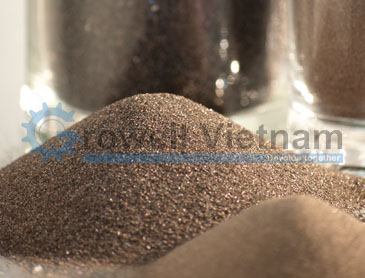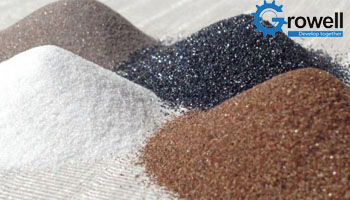News
How to choose the right abrasive sand?
Abrasive blasting is the general term applied to finishing processes that entail the high-pressure propulsion of a stream of abrasive material onto the surface of a workpiece. Abrasive sand serve many surface finishing purposes, such as removing contaminants or previous coatings, altering the shape and smoothing or roughening the surface.
There are many types of abrasive blasting applications. Each of which requires the use of different types of abrasive sand. In this article, Growell VN will help you select the right abrasive sand suitbale to your needs.

Common abrasives sand
Glass beads
Glass is not as aggressive a blasting media as other materials, such as steel shot or silicon carbide. However, it is an excellent choice for applications that require a softer, brighter finish. It is well suited for stainless steel applications. Glass beads can also be recycled multiple times.
Aluminum oxide
Aluminum oxide is characterized by its superior hardness and strength. It can be found in applications ranging from anti-slip surfaces, industrial applications as a blasting media, and as a raw material in refractories. It is designed for abrasive pressure blasting of almost any type of substrate: glass, granite, marble, and steel. Due to its ability to deeply etch it is used in the preparation of surfaces prior to painting or coatings.
Steel shot and steel grit
Steel shot and steel grit is a cost-effective alternative to other abrasives due to its toughness and high recyclability. It can be used on a variety of surfaces to effectively remove contaminants, texture a surface for proper adherence of a final coating, or in peening (hardening) applications. The correct size, hardness and shape play a significant role in the proper abrasive selection.
Criteria for selecting suitable abrasive sand

Size
The smaller the size of abrasive sand, the smaller force acting on the surface and vice versa. The bigger size, the greater force of bombardment, but the cleaning time will be longer.
Besides, the size of abrasive sand also affects the roughness of surface. The bigger size, the more roughness is. For example, steel shot S390 (1.2mm) will make the roughness to be about 60 – 80 micron. But steel shot S070 (0.3 mm) just can make the roughness to be about 10 – 15 micron. S070 is used much for cleaning car, motorbike or casting parts because it provides a smooth surface for painting.
Hardness
The hardness of abrasive sand affects its cleaning efficiency and useful time. The higher the hardness, the greater the cleaning effect. But high hardness will make the abrasive sand’s efficiency time to be shorter.
Cleaning efficiency and crushing ability of steel shot correspond to each other. Steel shot with higher hardness is more likely due to its ability to withstand low impact forces, but has good abrasion resistance as well as great cleaning efficiency.
Therefore, when choosing the hardness of abrasive sand, we have to consider cleaning cost, which takes into account the cleaning time, not just purely on the abrasive sand’s life and crush ability.
Material
Different materials need to use abrasive sand with different size. Besides, depending on the materials, the abrasive sand consumption is also diffrent. For example, 1 ton steel shot can clean about 150 tons aluminum materials. But 1 ton steel shot can clean only 80-100 tons steel materials.
For cleaning stainless materials, you can use glassbead #60 to clean or blur surface. In order to spray or engrave headstone, you can use brown aluminum oxit F60 or F80.
CONTACT US NOW TO GET MORE DETAILED CONSULTANCY ON HOW TO CHOOSE ABRASIVE SAND SUITABLE TO YOUR NEEDS

Reference articles:
SG125 – Specially cleaned steel ball beads for steel structures
Summary of frequently asked questions when using Sand Blasting Machine






